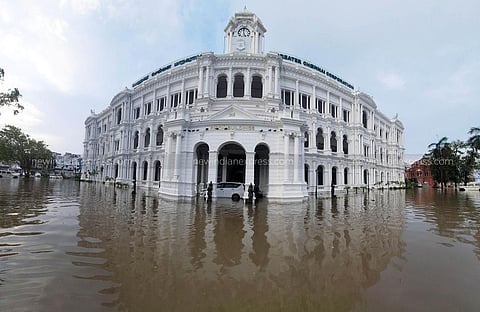

I received a very appropriate WhatsApp message during the recent rains in Chennai: January to October—water scarcity; November to December—water scares city.
How long do we have to put up with this annual horror of water entering homes, sometimes even mixed with sewage and petrol? People die every year. The city has to shut down; offices, schools, colleges and factories close; there is no public transport … and we call ourselves a mega smart city! Who can forget the floods of 2015, when over 400 people lost their lives and boats became the mode of transportation? It is convenient to restrict the blame to climate change and extreme weather events for the flooding. But knowing that this is a frequent event, how is the government planning to cope? It is the poor who suffer, whose homes are destroyed. And animals have to starve with no source of food.
Chennai has 2,780 kilometres of roads. But the storm water drains are limited to 1,894 kilometres. Knowing that the city is prone to floods and cyclones, we need much more; it has been suggested that the city needs about 5,000 kilometres of storm water drains. Then comes the maintenance of these drains, which are choked with plastic. And when the water is pumped out of low-lying areas, it goes back to the same streets and into homes. There is no flood management plan. For instance, for the past two weeks, water has been pumped out of Seethamma Road in Alwarpet to TTK Road. It makes a U-turn and goes back into Seethamma Road. The residue even enters homes; our pathways are full of water mixed with petrol. Frightening!
Finally comes the poor management of reservoirs. When they almost begin to overflow, the sluice gates are conveniently opened for water to rush out and into the city. This year, when the reservoirs were opened, the water rushed out with fish, which were caught by children on the streets of T Nagar. Where could the water go? If harvested properly, we would never have a water problem in Chennai city.
The two freshwater rivers—Cooum and Adyar—are stagnant with sewage and garbage. If they could be cleaned up and only treated wastewater allowed to flow into them, that would be one more source for rainwater drainage. But there is too much corruption involved for the government to do the right thing. T Nagar, Lake Area, Chrompet, parts of Mylapore, Velachery, Pallikaranai, etc., have come up on eris or water bodies. All the water bodies of Chennai have been filled with garbage and sold to contractors. This has been a very lucrative business for politicians and bureaucrats of every hue. So where can the rainwater go?
Meanwhile, the city faces water shortages every summer. The defining image of Chennai, according to visitors to the city, is the row of colourful plastic pots lined up before a hand pump. We are unable to store the excess rainwater and use it in the hot dry summer. Chennai is a city dependent on groundwater but rainwater harvesting is a myth. The tall constructions with multiple residents are sucking out water faster than a 10 HP motor pump. The temple tanks that maintained groundwater levels have slowly been filled up. Marundeeswarar Temple in Thiruvanmiyur, which once had five tanks, has only one left today. The rest have given way to constructions and even a bus stand.
Since 2015, the year of the terrible floods, the city administration has tried to build storm water drains in flood-prone areas. But the Adyar and Cooum are yet to be unclogged. The unplanned growth of the city has led to the filling up of lakes and tanks and shrunk wetlands. A large wetland, Pallikaranai, has been converted into residential colonies, institutions and even a large garbage dump. The mass rapid transit system has restricted the flow of rain water into Buckingham Canal, which was originally designed as a protective barrier against floods. Over 300 lakes, tanks and canals have disappeared in the past decades and, according to the administration, over 1.5 lakh illegal constructions choke the cityscape. In 1893, there were 60 large water bodies in Chennai. Now only four remain: Red Hills, Cholavaram, Poondi and Chembarambakkam, with a combined capacity of about 11,000 mcft, of which 5 mcft is lost daily due to evaporation. Chennai is supplied 985 mld of water per day against the required amount of 1,200 mld. So water shortage is a perennial problem.
The water quality is also not even. Some areas have high total dissolved solids (TDS), while saltwater intrusion is a problem along the coast, which once had fresh water. One cannot imagine drinking water out of a tap. It is the source of every possible infection.
This is not the story of Chennai alone. Most Indian cities have permitted precious natural assets such as rivers, streams and lakes, which were the primary reason for their adoption and development as urban centres, to be filled up for construction purposes. Every year cities like Mumbai are flooded. Nowadays even inland cities like Hyderabad are suffering the same fate. This is due to poor planning. Contractors bribe politicians and officials and put up buildings on water bodies with no way for water drainage. Nobody is willing to bell the cat.
Chennai will have to restore at least some of its lost water spaces—the eris or lakes—and its two rivers, which have been reduced to large drains, in order to better withstand the vagaries of extreme weather events and preserve some water for the coming summer months. The people of this city are fed up with regular annual floods and droughts, which also lead to power cuts, high vegetable prices, shortages of essential commodities and a total breakdown of normal life. Chennai residents have to wade through water mixed with sewage and lose precious lives and limbs. Who will save us from our annual water woes?
Nanditha Krishna, Historian, environmentalist and writer based in Chennai (nankrishna18@gmail.com)